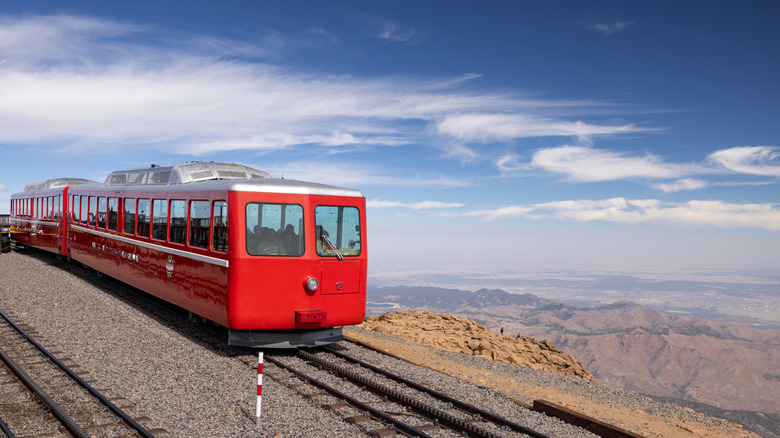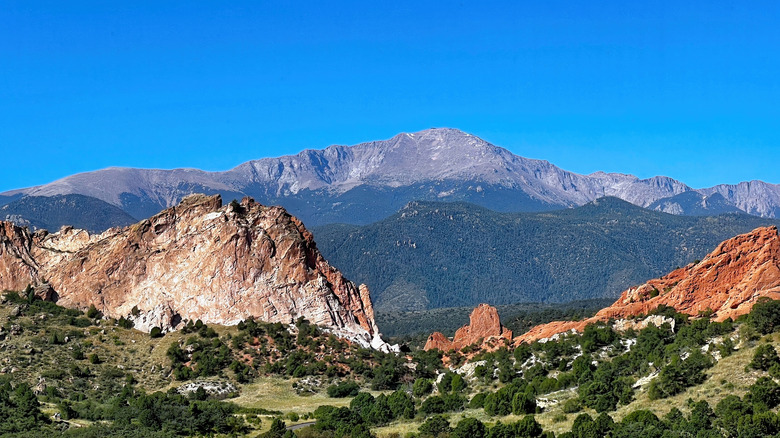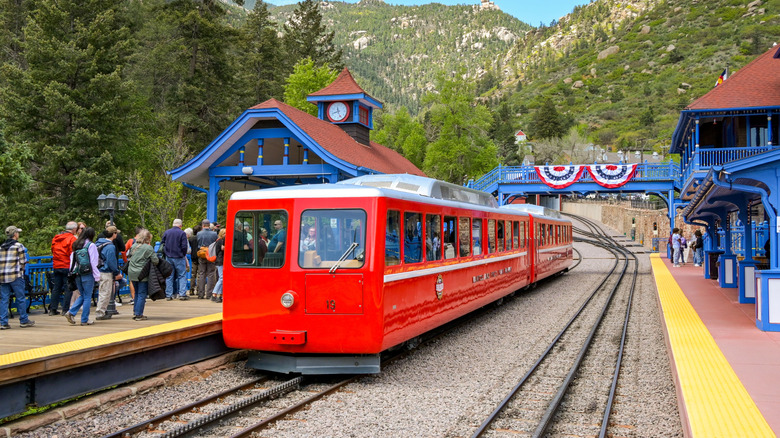This Scenic Train Ride Through Colorado's Rocky Mountains Showcases Wildlife And Aspen Groves
The list of destinations you have to visit on a trip to Colorado is a long one, including epic ski resorts like Aspen and Steamboat springs, the Garden of the Gods public park, Mount Blue Scenic Byway, and Denver, an adventure-loving city that's also one of America's street art capitals. But wherever you go, your journey will likely be set against a gorgeous Rocky Mountain backdrop. And one of the best ways to see one of America's most iconic mountain ranges is by railway.
When it was constructed in 1891, the Broadmoor Manitou and Pikes Peak Cog Railway was the highest railway of its kind in the world — a status it retains to this day. It was built to ferry passengers along the ascent of Pikes Peak, known colloquially as "America's Mountain," in the heart of Colorado. One of only two cog railways in America, it climbs to over 14,000 feet and offers vertiginous, panoramic views that few other train cars in the world could match.
Amtrak's Texas Eagle might be America's longest train ride, but surely the Pikes Peak Cog Railway is one of its most epic. They say it was here, in the summer of 1893, that poet Katherine Lee Bates surveyed those beautiful, spacious skies and "purple mountain majesties, above the fruited plain." After all, appellations like "America's Mountain" don't get handed out for no reason.
Take in views of the Rocky Mountains and wildlife on the Pikes Peak Railway
The railway uses a cog mechanism to claw its way up the mountain — conventional railway mechanics wouldn't generate enough traction to propel the car forward — along 9 miles of track. Starting in the Eastern Plains, it moves up through thickets of sagebrush and scrub oak in the Rocky foothills, before traversing subalpine and alpine zones, where the trees and signs of wildlife begin to thin. En route to the summit, the train winds magnificently through Pike National Forest, where aspens and maples paint the landscape golden-orange each fall, and where bristlecone pines have watched the seasons come and go for 2,000 years.
Colorado's wildlife may join you to admire the scenery. Between 6,000 and 10,000 feet, you'll see the likes of prairie dogs and rabbits at lower elevations, then raccoons, deer, bears, elk, and mountain lions as you ascend. From 10,000 to 11,500 feet is where some of oldest and hardiest bristlecone pines thrive alongside spruce and fir trees — look out for the chipmunks and squirrels that call the trees home. The alpine zone above 11,500 is mostly unforgiving tundra, where only the toughest mosses and wildflowers grow. That said, yellow-bellied marmots and bighorn sheep flock up here in the summer to bask in the Colorado sun.
How to ride a train to the peak of a Colorado 14er
The railway sets off from Manitou Springs, a small city at the foot of Pikes Peak. It takes about an hour to reach the summit, so you're hardly moving at pace, but it certainly beats the transport of yesteryear: a two-day trip on the back of a (presumably) disgruntled mule. You'll get around 40 minutes at the top of Pikes Peak to take in the views and have a look around the visitor center — and try its famous altitude donuts — before descending back to Manitou Springs.
Tickets range from $60 to $90 per adult for a round trip. The train runs in every season, though the golden hour of a summer evening or a crisp fall afternoon is probably the best time to go. Note, though, that even in summer, snow can fall and a chill can settle on the mountaintop when you're at 14,000 feet. Announcements on the platform at Manitou Springs will inform you of the temperature at the summit before you depart, but it's worth packing a warm jacket regardless the season.


